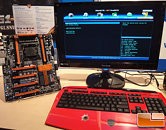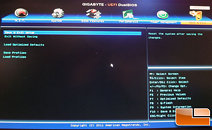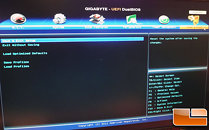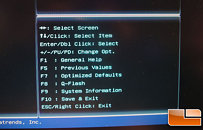- Joined
- Oct 9, 2007
- Messages
- 47,621 (7.44/day)
- Location
- Dublin, Ireland
| System Name | RBMK-1000 |
|---|---|
| Processor | AMD Ryzen 7 5700G |
| Motherboard | Gigabyte B550 AORUS Elite V2 |
| Cooling | DeepCool Gammax L240 V2 |
| Memory | 2x 16GB DDR4-3200 |
| Video Card(s) | Galax RTX 4070 Ti EX |
| Storage | Samsung 990 1TB |
| Display(s) | BenQ 1440p 60 Hz 27-inch |
| Case | Corsair Carbide 100R |
| Audio Device(s) | ASUS SupremeFX S1220A |
| Power Supply | Cooler Master MWE Gold 650W |
| Mouse | ASUS ROG Strix Impact |
| Keyboard | Gamdias Hermes E2 |
| Software | Windows 11 Pro |
Gigabyte surprised many last year, when it broke its decade-long tradition of blue-colored PCBs to unveil its first black ones. Pictures of the first black PCB Gigabyte boards were first dismissed as Photoshop jobs, but after some confirmation, news posts carried quite some shock-value. It's such small things that Gigabyte has known to be quite particular about. Not that it's bad, Gigabyte is the second biggest motherboard vendor because many of its rigid design policies paid off, but some of these could work against the company.
One such has been the company's reluctance to use UEFI firmware on its motherboards. With socket LGA1155 and AM3+, we saw motherboard vendors of all shapes and sizes, including much smaller ones such as BIOSTAR adopt UEFI. Besides allowing vendors to deploy mouse-driven graphical user interface for the CMOS Setup program, UEFI addresses many glaring limitations of legacy BIOS, which hasn't changed much over decades. UEFI allows you to boot from volumes bigger than 2.2 TB in size. Eventually, storage volumes several terabytes in size will become mainstream, and that's when the ticking time-bomb that is BIOS, will blow.




Gigabyte tried to address the limitation with what it calls "HybridEFI", which is nothing to do with UEFI, but is rather an address-space tweak for existing AwardBIOS code that allows you to boot from large volumes. That still leaves out the problem of Gigabyte's notably slow and convoluted CMOS setup program navigation. One genuine upside of HybridEFI is that Gigabyte has been able to provide BIOS updates to many of its older motherboards with 16 Mbit EEPROMs, that give them the feature. Gigabyte is hence the only motherboard vendor with socket LGA775, LGA1156, LGA1366, and AM3 motherboards that can boot from >2.2 TB volumes.
Finally, it seems like Gigabyte broke another big "tradition", that of using AMI BIOS over AwardBIOS. Award doesn't seem to have a template UEFI firmware that vendors can work their own UIs on. Gigabyte's BIOS team is known to have programmers who have had first-hand experience in programming AwardBIOS, which could explain the company's slow transition to UEFI. Spotted on working models of Gigabyte's LGA2011 X79 motherboards on display at IDF, Gigabyte is using an AMI UEFI BIOS with its own GUI. Add to this, Gigabyte found a way to give its AMI BIOS the huge advantage of its patented DualBIOS technology, an automatic redundant EEPROM switching technology that protects from damaged BIOS or failed BIOS flashing.
View at TechPowerUp Main Site
One such has been the company's reluctance to use UEFI firmware on its motherboards. With socket LGA1155 and AM3+, we saw motherboard vendors of all shapes and sizes, including much smaller ones such as BIOSTAR adopt UEFI. Besides allowing vendors to deploy mouse-driven graphical user interface for the CMOS Setup program, UEFI addresses many glaring limitations of legacy BIOS, which hasn't changed much over decades. UEFI allows you to boot from volumes bigger than 2.2 TB in size. Eventually, storage volumes several terabytes in size will become mainstream, and that's when the ticking time-bomb that is BIOS, will blow.




Gigabyte tried to address the limitation with what it calls "HybridEFI", which is nothing to do with UEFI, but is rather an address-space tweak for existing AwardBIOS code that allows you to boot from large volumes. That still leaves out the problem of Gigabyte's notably slow and convoluted CMOS setup program navigation. One genuine upside of HybridEFI is that Gigabyte has been able to provide BIOS updates to many of its older motherboards with 16 Mbit EEPROMs, that give them the feature. Gigabyte is hence the only motherboard vendor with socket LGA775, LGA1156, LGA1366, and AM3 motherboards that can boot from >2.2 TB volumes.
Finally, it seems like Gigabyte broke another big "tradition", that of using AMI BIOS over AwardBIOS. Award doesn't seem to have a template UEFI firmware that vendors can work their own UIs on. Gigabyte's BIOS team is known to have programmers who have had first-hand experience in programming AwardBIOS, which could explain the company's slow transition to UEFI. Spotted on working models of Gigabyte's LGA2011 X79 motherboards on display at IDF, Gigabyte is using an AMI UEFI BIOS with its own GUI. Add to this, Gigabyte found a way to give its AMI BIOS the huge advantage of its patented DualBIOS technology, an automatic redundant EEPROM switching technology that protects from damaged BIOS or failed BIOS flashing.
View at TechPowerUp Main Site
Last edited:







